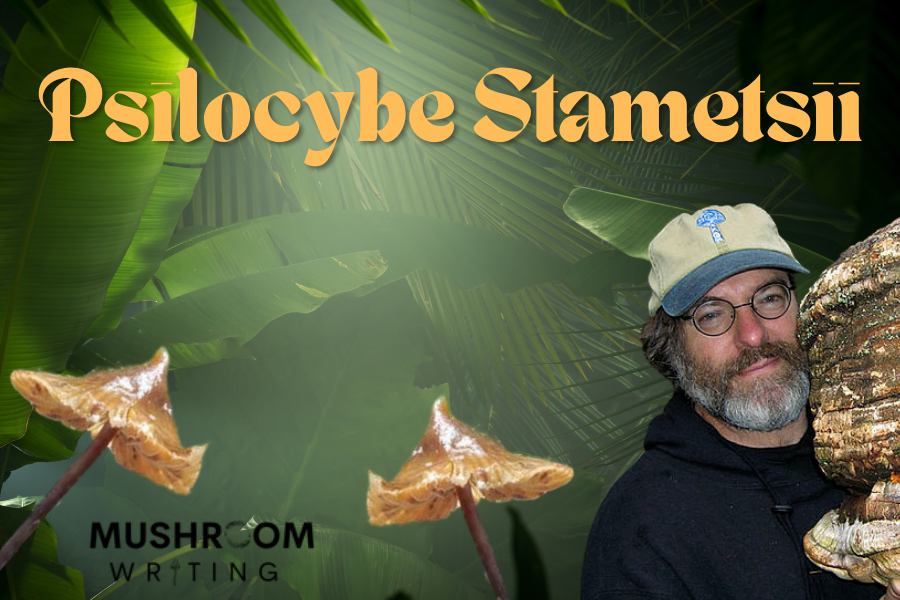Psilocybe stametsii is a recently discovered magic mushroom species that has been given its name in honor of Paul Stamets, a renowned advocate of fungi who has inspired countless people globally.
Approximately 14,000 mushroom species have been described so far. Mycologist estimate that it’s not even 10% of all the fungi that are growing across our beautiful planet. Psilocybin mushrooms have been used in various rituals for ages, and yet there is so much to be discovered.

Who Is Paul Stamets?
Paul E. Stamets is a mycologist and entrepreneur from the United States. He runs a company that sells a variety of mushroom products and is well-known for his advocacy and authorship of medicinal fungi and mycoremediation.
Stamets became interested in mycology thanks to his late brother, John, and pursued it as an undergraduate student. Despite not having pursued higher education beyond a bachelor’s degree, he is mainly self-taught in the field of mycology. In 2014-2015, he received the Invention Ambassador award from the American Association for the Advancement of Science (AAAS).
Stamets is a renowned expert on mushrooms in the Pacific Northwest region of the United States. Over the course of decades, he has discovered and co-authored four new types of psilocybin mushrooms, namely Psilocybe azurescens, P. cyanofibrillosa, P. liniformans var. americana, and P. weilii. Stamets has shared his knowledge and experience on psilocybin mushrooms through lectures at universities and seminars and slide presentations across the world.
He is the author of several books, including Psilocybe Mushrooms and Their Allies, The Mushroom Cultivator (co-authored with Jeff S. Chilton), Growing Gourmet and Medicinal Mushrooms, Psilocybin Mushrooms of the World, and his latest work, Fantastic Fungi: How Mushrooms Can Heal, Shift Consciousness & Save the Planet.
In the book “Mushroom Pioneers” by John W. Allen, he is recognized as one of the trailblazers in the field of mushrooms.

What’s Psilocybe stametsii?
It’s estimated that only a small fraction of the world’s fungi has been identified so far, no more than 10%. Documenting new species like psilocybe stametsii is establishing a benchmark for biodiversity among the world of fungi.
Psilocybe stametsii is a small species of mushroom with a dark brown, pointed cap perched on a stem the size of a matchstick. The cap of this mushroom somewhat resembles a witch hat, just adding to its astounding appearance.
Mushroom specie named after Paul Stamets was collected only on two occasions. Found in the cloud forest of Ecuador, the first collection was made in 2011 by Dr. Bryn Dentinger. The second collection was made by Giuliana Furci of the Fungi Foundation in 2022. The mushroom was discovered within the confines of the Los Cedros Biological Reserve.
Established in 1988, the Los Cedros Biological Reserve is located in north-western Ecuador and spans across an area of 11,861 acres. It consists of a premontane wet tropical forest and a cloud forest. More than 10,117 acres of the reserve comprises primary forest. It serves as the southern buffer zone for the 450,000-acre Cotocachi-Cayapas Ecological Reserve. Both reserves are part of the Choco Phytogeographical Zone – one of the most biologically diverse and endemic habitats on Earth.

The Description of P. stametsii
It typically grows to a height of 3.5-4.5cm, with a brown to dark yellow/ochre cap that becomes dry and striated. The cap is conical to campanulate in shape, with a distinct, sharp umbo or papillate, and the margin becomes uplifted and somewhat plicate in age. The context is thin, up to 1-1.5cm in diameter.
The gills are pale brownish-cream colored at first, becoming light brown in age. They are subdistant with two sets of lamellulae, broad, adnexed or sinuate, and have an even margin. The stipe is central, terete, equal to flexuous, slightly stuffed becoming hollow. The exterior is slightly pruinose, dry, and dark brown/blackish at the base, fading to red and then pale orange at the apex. The stipe can grow up to 3-4cm long and has a diameter of about 1mm. When damaged, the stipe can exhibit slight bluing.
The spores are smooth and small, with a subrhomboid to rhomboid shape and slightly thickened cell walls. They have an apical germ pore and are translucent-brown under the microscope. The spores measure (3.0-)3.5 x (2.5-)3.0μm. Cystidia are also present, lageniform to urtiform, cell walls not thickened, hyaline in 5% KOH. Slight bluing occurs on the stipe when damaged.

Final Word
The discovery of Psilocybe stametsii is a testament to the vast biodiversity of the world of fungi. It is a fitting tribute to Paul Stamets, an influential mycologist, and advocate of fungi, who has made significant contributions to the field. His expertise and passion have inspired countless individuals globally to explore the vast and fascinating world of mushrooms. The discovery of this new species is also a reminder of the critical importance of preserving Biological Reserves worldwide, as they truly are vital for our ecosystem and biodiversity.
